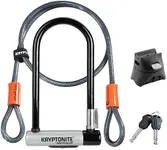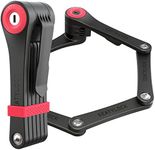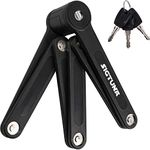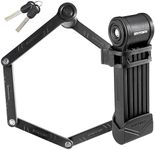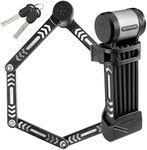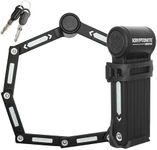Buying Guide for the Best Folding Bike Lock
Choosing the right folding bike lock is essential for keeping your bike secure while also making sure the lock is convenient to carry and use. Since folding bikes are often used for commuting and urban travel, you'll want a lock that balances security, portability, and ease of use. Understanding the key features of folding bike locks will help you make a smart choice that fits your lifestyle and security needs.Security LevelThe security level of a folding bike lock refers to how resistant it is to theft attempts, such as cutting, prying, or picking. This is important because the main purpose of a lock is to protect your bike from being stolen. Security levels are often rated by independent organizations or the manufacturer, ranging from basic to high security. If you park your bike in high-risk areas or leave it unattended for long periods, choose a lock with a higher security rating. For quick stops in low-risk areas, a moderate security level may be sufficient.
WeightWeight is how heavy the lock is, and it matters because you'll be carrying it with you, often on your bike or in a bag. Heavier locks tend to be more secure, but they can be cumbersome, especially if you value portability. Lightweight locks are easier to carry but may offer less protection. If you prioritize convenience and have a short commute, a lighter lock might be best. If security is your top concern and you don't mind the extra weight, go for a heavier option.
Size and Folded DimensionsThe size and folded dimensions refer to how compact the lock becomes when not in use and how much space it takes up when locking your bike. This is important for folding bike users who often have limited storage space. Smaller, more compact locks are easier to carry and store, but may not fit around larger objects. Larger locks can secure your bike to a wider range of fixtures but may be bulkier. Consider where and how you plan to lock your bike, and choose a size that fits your typical parking situations.
Locking MechanismThe locking mechanism is how the lock opens and closes, such as with a key or a combination code. This matters for both security and convenience. Key locks are generally more secure, but you need to keep track of the key. Combination locks are convenient since you don't need a key, but they can be less secure. Think about your preference for convenience versus security, and whether you’re likely to lose a key or forget a code.
Mounting SystemThe mounting system is how the lock attaches to your bike when not in use. A good mounting system makes it easy to carry the lock without it rattling or getting in the way. Some locks come with brackets that attach to the bike frame, while others may need to be carried in a bag. If you want quick access and minimal hassle, look for a lock with a reliable and easy-to-use mounting system that fits your bike.
Material and Build QualityMaterial and build quality refer to what the lock is made of and how well it is constructed. Strong materials like hardened steel offer better protection against cutting and sawing. Good build quality also means the lock will last longer and resist weather damage. If you need a lock for daily use or harsh weather, prioritize strong materials and solid construction. For occasional use in mild conditions, you might be able to compromise a bit on this aspect.

